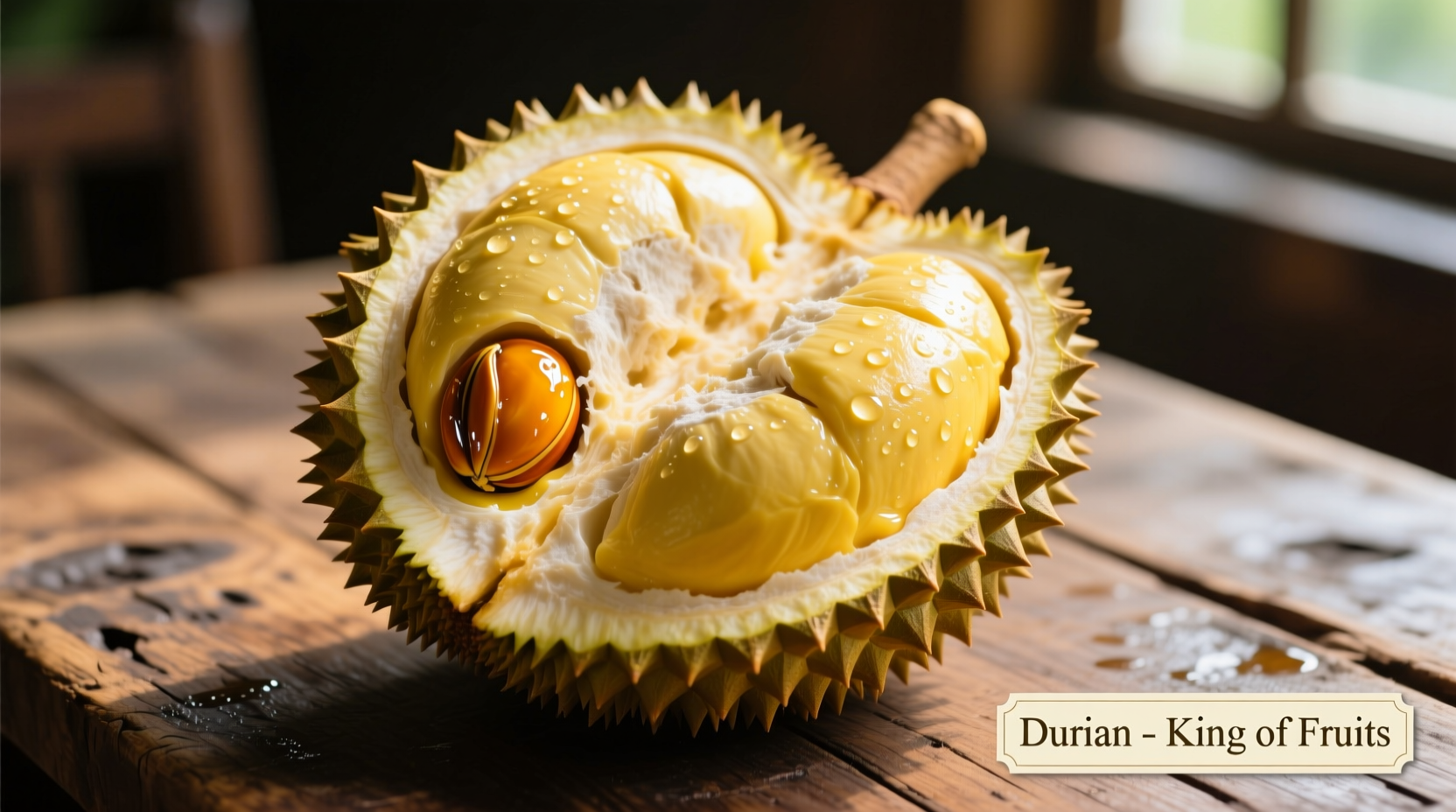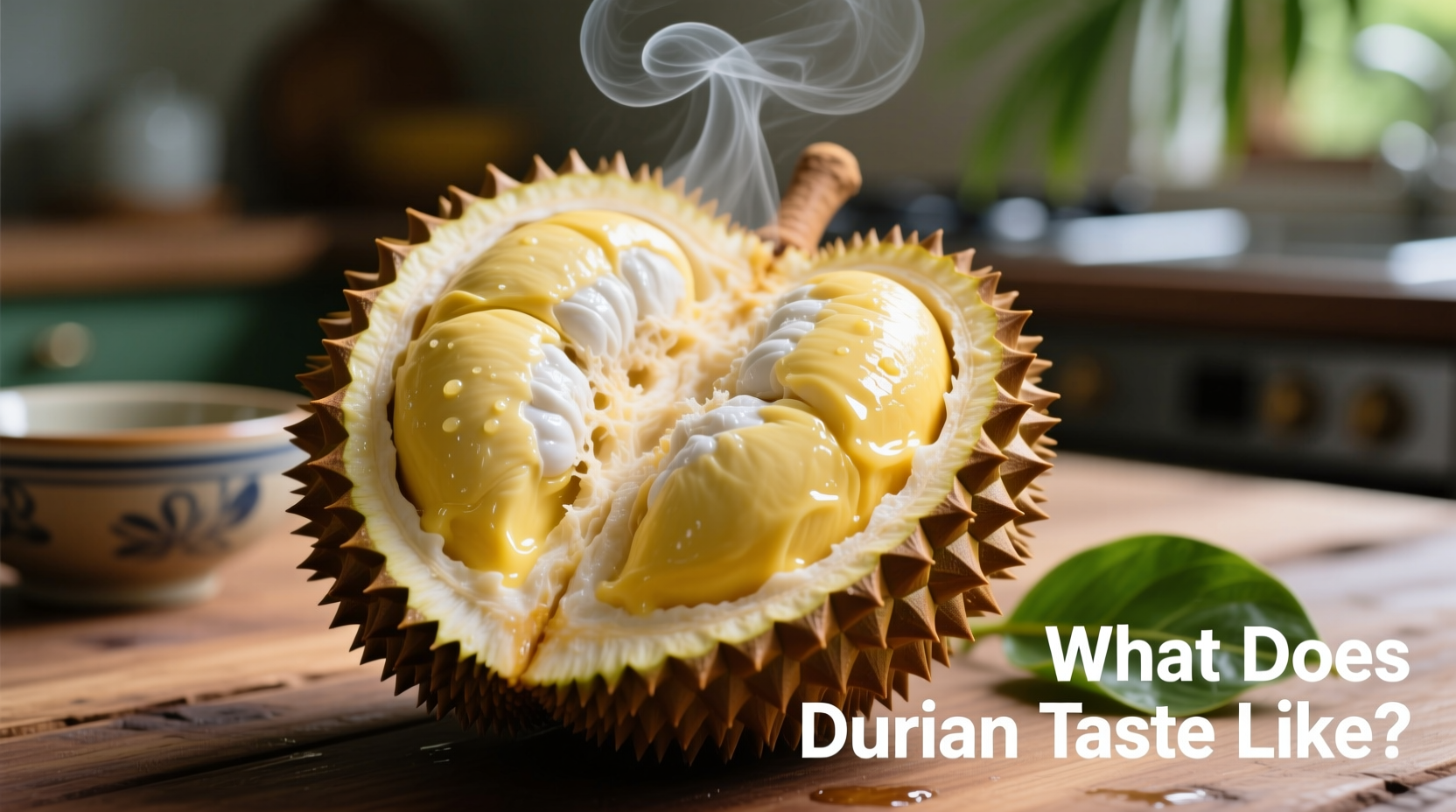If you've ever wondered what does durian fruit taste like, you're not alone. This "king of fruits" from Southeast Asia delivers one of nature's most polarizing sensory experiences. While its aroma might remind some of gym socks or sewage, the actual taste reveals surprising complexity that has captivated palates for centuries.
The Multi-Layered Flavor Experience
When you take your first bite of durian, you'll immediately notice its rich, custard-like texture that melts in your mouth. The initial flavor impression is predominantly sweet with distinct notes of:
- Caramelized sugar
- Vanilla bean
- Almonds
- Ripe banana
- Crème brûlée
Beneath this sweetness lies a fascinating savory dimension that creates durian's signature complexity. Food scientists have identified over 50 volatile compounds contributing to durian's flavor profile, with ethanethiol being primarily responsible for its notorious aroma while esters create the sweet, fruity notes.

Understanding Durian's Aroma Paradox
One of the most common questions is why does durian smell so strong but taste sweet. This disconnect between aroma and flavor occurs because:
- The sulfur compounds that create the pungent smell (similar to onions and garlic) break down when heated or mixed with saliva
- Our sense of smell contributes significantly to flavor perception (up to 80%)
- The creamy texture coats the palate, muting some of the stronger aromatic compounds
According to research published in Nature Genetics, durian produces a compound called ethanethiol that triggers our olfactory receptors at extremely low concentrations - explaining why the smell carries so far while the taste remains surprisingly pleasant.
Durian Variety Taste Comparison
| Variety | Taste Profile | Aroma Intensity | Best For |
|---|---|---|---|
| Musang King | Bitter-sweet with complex caramel notes | ★★★★☆ | Experienced durian enthusiasts |
| Red Prawn | Sweeter, less bitter with jelly-like texture | ★★★☆☆ | First-time eaters |
| Monthong | Mild, creamy with subtle sweetness | ★★☆☆☆ | Western palates |
| D101 | Strong bitter notes, complex flavor | ★★★★★ | Culinary applications |
Texture: The Creamy Component
Texture plays a crucial role in what does durian fruit taste like. Unlike most fruits, durian has a dense, custard-like consistency that ranges from smooth and creamy to slightly fibrous depending on ripeness and variety. This rich mouthfeel enhances the perception of sweetness and carries the complex flavor compounds across your palate.
Food scientists measure durian's texture on the Brix scale (sugar content) and find most premium varieties register between 25-35°Bx - significantly sweeter than mango (14-24°Bx) or banana (15-28°Bx). This natural sweetness balances the savory elements that might otherwise dominate.
Cultural Perspectives on Durian Taste
Understanding how to describe durian taste to someone requires cultural context. In Southeast Asia, where durian originates, the fruit is celebrated with dedicated festivals and markets. Locals often describe it using terms like "harmonious" and "complete" - suggesting all flavor elements work together perfectly.
A 2023 sensory study conducted by the University of Singapore surveyed 500 participants across different cultures:
- 87% of Southeast Asians described durian as "deliciously complex"
- 63% of Western participants initially found the aroma off-putting but 78% enjoyed the taste after trying it
- Only 12% reported disliking both the smell and taste after multiple exposures
This demonstrates that durian appreciation often grows with exposure - a phenomenon food scientists call "acquired taste adaptation."
Practical Guidance for First-Time Tasters
If you're wondering what does durian taste like first time, here's what to expect and how to maximize your experience:
- Start with milder varieties like Monthong or Red Prawn rather than intensely flavored Musang King
- Cool the fruit slightly - refrigeration reduces aroma intensity by 30-40% according to food science research
- Take small bites and let the fruit melt on your tongue rather than chewing vigorously
- Pair with complementary flavors like sticky rice or coconut milk to balance the intensity
- Give it multiple tries - most people need 2-3 exposures to fully appreciate durian's complexity
Scientific Breakdown of Durian's Flavor Compounds
Researchers at the National University of Singapore have identified the key compounds that create durian's distinctive durian fruit flavor profile explained:
- Esters (42% of volatile compounds): Create sweet, fruity notes similar to banana and pineapple
- Sulfur compounds (28%): Responsible for the pungent aroma (ethanethiol, similar to skunk spray)
- Aldehydes (15%): Contribute nutty, buttery flavors
- Alcohols (9%): Add floral notes
- Ketones (6%): Provide creamy, buttery elements
Interestingly, the same sulfur compounds that create the strong smell also contribute savory umami notes when they interact with saliva, explaining why durian's taste is more complex than its aroma suggests.
How to Select the Best Durian for Optimal Flavor
Your durian tasting experience depends heavily on proper selection. Follow these science-backed tips for the best different types of durian taste comparison experience:
- Listen for the right sound - gently shake the fruit; you should hear the seeds moving slightly, indicating proper ripeness
- Check the stem - a green stem means underripe, while a brown stem suggests overripeness; ideal is yellow-green
- Smell the base - a strong but not overpowering aroma indicates peak ripeness
- Feel the spikes - they should be slightly flexible, not rigid or brittle
- Look for slight separation between segments, showing the fruit has naturally opened
Remember that durian continues ripening after harvest, so the flavor profile evolves significantly in the 2-3 days following purchase. For the most balanced taste, consume when the aroma is noticeable but not overwhelming.
Conclusion: Embracing Durian's Complexity
Understanding what does durian fruit taste like requires moving beyond the initial aroma shock to appreciate its remarkable flavor complexity. This fruit offers a unique sensory journey that combines sweet, savory, creamy, and aromatic elements in a single bite. Whether you're a curious foodie or planning your first durian experience, approaching it with an open mind and proper preparation will help you discover why millions consider it the "king of fruits" despite its controversial reputation.











 浙公网安备
33010002000092号
浙公网安备
33010002000092号 浙B2-20120091-4
浙B2-20120091-4